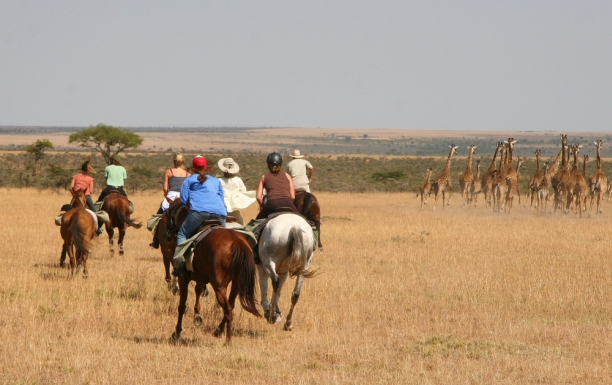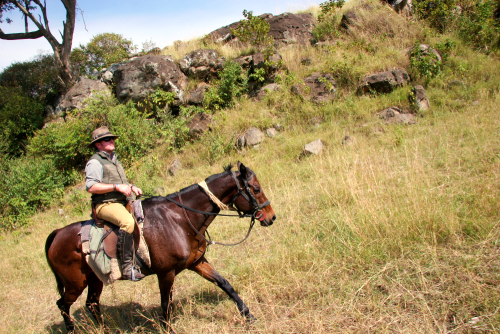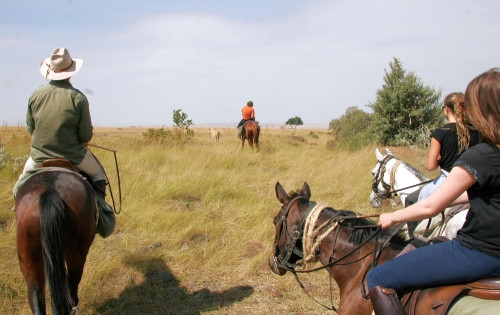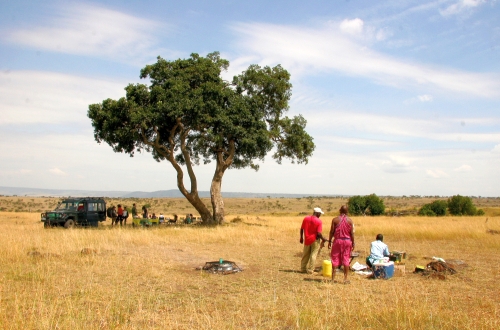Horsing Around The Masai Mara

“It’s like the Garden of Eden,” our guide says, looking over the vista of Kenya’s famed Masai Mara National Reserve, “just beautiful . . .” We draw up our reigns to marvel in silent reverence at the vast landscape, dotted with every wild animal we could have hoped to see.
Across this lush, buzzing vista, buffalo herd around impala, eagles soar above wildebeest and elephants charge fruit trees while lions wait patiently in the tall savanna grass, deciding which to eat for dinner.
Getting here is not easy, and it takes days of hard riding to earn a seat at this show.
Our journey begins in the capital, Nairobi, where we transfer through gridlock traffic to an airport and board a 12-seat Cessna, heading southwest over the Loita Plains, above the Kikuyu Highlands and past the volcano-studded Great Rift Valley.
An hour later we’re bumping down on a dirt-strip that doubles as a gateway to the reserve and a social hotspot for colorfully-dressed Masai warriors. With no phone signal and no electricity from here on in, it also represents the eye of a needle through which few First-World foibles may pass.
From here, a Land Rover bumps us along remote, red dirt roads to a campsite set in a grove of acacia trees. This would be the first of three such sites, and traversing between them for up to six hours a day on horseback will require every inch of riding skill we have.
There’s barely time for a cold Kenyan Tusker beer before we’re heading out on our first ride when the sun hangs low enough to bring the wildlife out to feed. Here, the guides quietly make their assessments about your riding abilities and how closely they need to stick to you, and whether you’ve been paired with the right horse.
We’re international bunch: a half-Argentinian, half-Austrian lifer (he started working with our tour company, Offbeat Safaris, at 18, and he’s still there at the age of 33), an Australian polo player from Dubai, a British safari guide from Botswana, and a student volunteer and hunter from England. All told, the guests were from the U.K., U.S., Germany, Italy and Australia.
The horses were Abyssinian, thoroughbred and cross-thoroughbreds, reared on the owner’s farm, and brought into the reserve via a seven-hour horsebox slog. Mine was a pristine, polo-playing gelding named Blondie, looking decidedly bling with his dash of gold flecks and bright yellow mane. After half an hour of sizing each other up at the beginning, we knew we’d get on fine.

Being confident on your horse could be the most important part of this adventure. Over the next week, we would inch — day-by-day — ever closer to prides of snarling lions, square up to scrappy elephants and push back short-tempered bison, all of which could outrun us, if they wanted to.
Being comfortable riding in English tack is important too, as I noticed the countryside Californians in our group had a hard time adjusting to the bolt-upright British saddles which are at odds with the Western-style “armchairs” they use back home.
The most accomplished riders tail the lead guide as he opts to take the most daring routes, jumping over felled trees left by head-charging pachyderm and playing chicken with lions which may or may not have eaten that day.
Every two to three days, our camp packs up and shifts by truck; with its canvas dining tent, shower, sleeping and toilet tents resembling a well-appointed commune when pitched at each of the three stunning oases.
On every moving day, there is an epic ride to reach the next site, which can be up to 30 miles away. That’s a lot of riding — at high altitude no less — across challenging terrain, galloping across plains pockmarked with aardvark holes and rocks, and cantering through stone-bed rivers with vertigo-inducing banks.

Along the way, animal burrows are a constant hazard, but if you’re lucky enough for the person in front of you to spot one through the dust clouds, avoid it and shout “Hole!” in time, you may not fall down it.
Organizers encourage guests to take out medical insurance prior to arrival, but they also have their own public liability insurance and membership to the Flying Doctors organization, in case of serious injury requiring evacuation.
Nevertheless, there’s a lot that can go wrong in the middle of nowhere. The riding sections will undoubtedly push you to your limits of self-preservation, whether you opt to take the easy option and stay back, or throw caution to the wind and try to keep up with the lead guide.
Bullwhips protect guests from animal attacks, with guides normally carrying little else. The Land Rover variant of the trip, for non-riders, encourages guests to get out and walk on the reserve, and here, they are accompanied by a guard carrying a rifle.
The one occasion we went out armed was to a mountain we climbed first by car, then by foot to reach its spectacular peak. Its nooks host several families of cheetah and leopard, which we were warned to be on our guard against, although we didn’t see any as we clambered about on its slopes.
We did not have to wait much longer before we did, though. On our first night at the third campsite, while we drinking beers around the fire on the banks of the Mara River, our lead Masai guard, Nati, came over saying he’d spotted a cheetah and asking if we wanted to see it. Several seconds later we were careering around the site in the Land Rover, shining a spotlight until suddenly we caught a flash of markings bolting into a bush.
Nati picked out an impala with the light, leading the cheetah out into the open to its quarry. The kill was artistic and eloquent in its execution despite the graphic scene; we drove over, clutching our beers on the roof of the car, and sat transfixed to watch it feed.
Other nighttime highlights included Masai warriors demonstrating their mating dance around the fire (a hit with the ladies); driving out to party on the plains after dark with James Brown booming from the stereo, and running semi-clothed out of my tent at 4 a.m. as an elephant pushed down a nearby tree.

Returning to my tent after dinner each evening, I would, without fail, find my riding boots cleaned and polished to perfection and my laundry scrubbed, pressed and folded as if at a top-notch hotel. The food and drink was impressive too, an array of cuisine cooked up from fresh, imported and locally produced ingredients. Riding for hours from the crack of dawn to emerge over a hill and find the camp’s chef cooking breakfast in the middle of the plains ranks, for me, as a new definition of decadence.
And our midday siestas in shady glades after picnic lunches were something to savor too, like falling asleep on the classroom rug after having your fill of milk and cookies at kindergarten.
At the end of the week, it was with some sadness that I watched my fellow guests leave, while I moved on to see the company’s guest lodge, another hour’s flight west.
The lodge at Sosian, the Samburu word for “Wild Date Palm,” combines the tame with the wild. It’s certainly a stark contrast to Masai camping; with its solid stone guest houses, swimming pool and main house that harks back to colonial days with a snooker table, grand piano and library.
Where the riding trip guests were in their 20’s and 30’s, at the game lodge the guests were mainly parents in their 40’s and 50’s with young children.
I immediately missed the unashamedly gonzo set-up of the anarchic riding outfit, with its unpredictable, scruffy lead guide riding in flip-flops, nights spent dancing around the camp fire and rock-hunting by moonlight on the plains to shore up the Land Rover’s wheels after we’d hit a hole.
For many visitors, Sosian will perhaps be the better-fitting choice; offering a quieter, safer and more luxurious bush experience on its 24,000-acre private working ranch, set on the Laikipia plateau.
It’s a beautiful area that offers more than 250 species of birdlife and an abundance of game species with four of the big five species being found there, plus other rarities such as wild dogs, Jackson’s hartebeest and Grevy’s zebra.
Nonetheless, I’d be back on the mad traveling horseback safari circus any day, at least for another few years.
*
Offbeat Safaris offers 7-night horseback safaris from $5,550 or 10 nights from $7,700 per person, and non-riders can take a Land Rover safari from $6,500.
By Richard Powell
Editor’s Note: Richard Powell is a freelance journalist who also works for the press release distribution, media monitoring and public relations firm, Presswire, but does not work with or for any of the parties mentioned in this article.

ABOUT THE AUTHOR
 Richard is a one-time journalism grad who started a public relations company after leaving BBC News. His company, Presswire, provides press release distribution and media monitoring services. As a freelance reporter, he provided correspondence from Kosovo, Northern Iraq, Sudan, Liberia and Beirut, but now concentrates on travel writing and news reporting.
Richard is a one-time journalism grad who started a public relations company after leaving BBC News. His company, Presswire, provides press release distribution and media monitoring services. As a freelance reporter, he provided correspondence from Kosovo, Northern Iraq, Sudan, Liberia and Beirut, but now concentrates on travel writing and news reporting.
